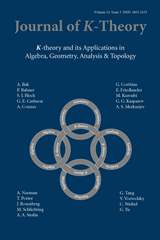Crossref Citations
This article has been cited by the following publications. This list is generated based on data provided by Crossref.
Young, Matthew B.
2016.
The Hall module of an exact category with duality.
Journal of Algebra,
Vol. 446,
Issue. ,
p.
291.
Brosnan, Patrick
and
Pearlstein, Gregory
2019.
Jumps in the Archimedean height.
Duke Mathematical Journal,
Vol. 168,
Issue. 10,
Bertrand, Daniel
and
Edixhoven, Bas
2020.
Pink’s conjecture on unlikely intersections and families of semi-abelian varieties.
Journal de l’École polytechnique — Mathématiques,
Vol. 7,
Issue. ,
p.
711.
Eskandari, Payman
and
Murty, V. Kumar
2023.
On unipotent radicals of motivic Galois groups.
Algebra & Number Theory,
Vol. 17,
Issue. 1,
p.
165.

